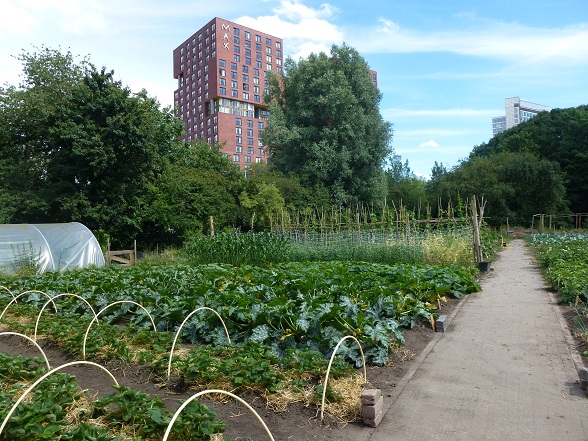Since a few months, I am living in Utrecht. Utrecht is a centrally-located city in the Netherlands, with around 350.000 habitants. It’s the fourth biggest city of the Netherlands and known for its historic city centre with the Dom Tower (112m high, the tallest building in the entire city), its university and its train station (the biggest in the whole country). As I moved here – a place which, even though I was born not far away from it, I knew very little about – I was looking for an opportunity to volunteer in some kind of local project. At the same time, I was considering the possibility of starting to grow some vegetables on my balcony. However, I quickly realised that this – growing vegetables on a balcony – requires a certain amount of knowledge and experience. Both issues were easily solved when I found out about the existence of ‘Food for Good’, a garden in the park not far away from my house. A few e-mails and conversations later I became a volunteer at this project.
Food for Good is a non-profit project aiming to bring people together through gardening. Since a few years, it is located on a piece of land in the corner of a park in one of the outer neighbourhoods of Utrecht, where it has developed a garden of about 7000m2 producing vegetables, fruits, herbs, flowers and honey. However, the main objective of the project is not, at first, the production of food but rather the social connection between the people working in the garden. The garden is open for everyone who has an interest in it: locals who wish to work in the garden as volunteers, people from the neighbourhood looking for some company and a cup of coffee, elderly people enjoying some small activities organised by the coordinators, and vulnerable people in need to be part of something. The atmosphere is relaxed, everyone is welcome, and there is no pressure when it comes to what you do or how good you are in doing it. Besides the people, another important characteristic is the focus on ecological farming, by using practices which support the ecological sustainability of the area. This way, bees are kept in a corner of the garden for pollination, crops are planted based on their impact on each other and on the soil, and a part of the garden has been ‘left to nature’ to increase biodiversity.
And it works! Besides the fact that it is a great experience to work together with other people in such a relaxed environment and hear their stories, the garden is now full of life and growing crops: strawberries, beans, tomatoes, garlic, cauliflower, zucchinis… It’s amazing to see it all grow, just with some sunshine, water and the care of all the people working there. The output is distributed among volunteers, used for cooking by elderly people, or sold for a small price to people who come by. Besides that many people find the company, the structure or the listening ears they were looking for while learning the tricks of gardening from each other.

Food for Good, in Utrecht
Projects and gardens like Food for Good have been popping up in urban areas all over the world. On the one hand, there is an urban lifestyle increasingly based on anonymity, work, full agendas, money and relationships through social media, and the counter-movement of people having a feeling that that’s just not the way it should be. On the other hand, of course, the growing awareness of the vulnerability of our ecosystem and the harm we do to it has increased the interest of people in the origin of the food we eat, local production of food and organic and biological farming practices. Urban farming provides a solid answer to both these trends, and therefore we have been hearing more and more about it.
Urban farming is as simple as that: the cultivation of food within an urban area. Of course, it has been around since ever and everywhere, as it is nothing shocking for people to grow some vegetables and herbs in their yard or, more recently, on their balcony. However, what has been trending is the idea or urban farming not simply as a way of surviving (as most of us have access to all kinds of food in the supermarket down the road) but more so as a movement. Urban farming is being seen as a way to increase access to locally grown products which do not need to be packed in plastic and travel miles and miles before reaching our kitchens. At the same time, urban farming reduces spoilage, as crops are consumed moments after being harvested, and allows for our relationship with what we eat to improve, by teaching us lessons about how food grows and the labour that is required during this process. This way, urban farming is no longer something done only by individual households, as examples of urban farms developed by businesses and non-profits are rising all around the world. At the same time, cities have become aware of its benefits and urban planners started to integrate urban farms in their projects. For example here in Utrecht, where a special department within the city council works on developing and improving these practices around the city.
Nonetheless, urban farming has one major disadvantage: the space available for agriculture within a city will never be enough to grow enough food to make a significant difference in what we eat. Dickson D. Despommier, a professor in Environmental Sciences at Columbia University, once asked his students to find out the potential of rooftop gardening. They calculated that, based on the estimated population of New York in 2050, the amount of calories that each person will need and the type of crops that can provide those calories, and considering that every square meter of rooftop in the city would be used for growing crops by this time, only around 2% of New York’s population could by fed. This brought Despommier to develop the idea of vertical farming: growing crops on multiple levels, the same way we got used to living in multiple level buildings. The bottom line of this idea is that, if we want to be able to produce enough food for the entire world population in, let’s say, 40 years from now, we need to change the way we think about agriculture and food production. Vertical farming ranges from traditional greenhouses of multiple levels to high-tech buildings where crops are grown without soil or natural light.

Food for Good, in Utrecht
One of the most impressive examples of vertical farming turned into practice is Aerofarms, a company growing crops in a former steel mill in Newark, New Jersey. After years of research, it is now growing food using the ‘ideal’ amount of moisture and nutrients, without the need of any natural sunlight, soil or pesticides. Besides the benefit of local food production (meaning less or no transportation costs, fresh fruits and vegetables and less or no intermediaries between the ‘farmer’ and the consumer), this type of urban farming brings along a variety of ecological benefits. According to Aerofarms, their method of farming requires 95% less water than traditional farming, preventing water contamination; it doesn’t require any pesticides as the environment in which the crops are grown is fully controlled and isolated from external influences; it requires only 1% of the land that traditional farming would require, avoiding soil erosion and biodiversity loss, and it allows for efficient waste management as the environment is fully controlled. At the same time, one could bring up the extensive use of energy as counter-argument, and question the replacement of nature by technology. However, as Despommier argues, agriculture isn’t a natural process, to begin with, but rather a man-made invention at the expense of natural ecosystems.
Urban farming has a huge potential in our urbanised world with its ever-growing population. On large scale, it can change the way we manage our food production and supply in creating systems which integrate all components from growing and harvesting to consuming on a local scale. The development of these ideas could eventually change the way our cities function: not as an urban epicentre which imports products from the ‘outside’ on a massive scale, but rather as self-functioning systems, or even as circular economies. On the other hand, projects like Food for Good show that change does not have to be radical or global to have impact. On small-scale, urban farming has the potential to change the way we live together, by looking at neighbourhoods as local communities which can work and produce together instead of agglomerations of people which ended up in the same place more or less by chance. Working together in a garden makes us healthier, even when, or maybe especially because, the main objective is not to be productive but to work together. Of course, Food for Good, a small scale project mainly run by volunteers and people with passion for gardening, and Aerofarms, a million dollar company aiming to radically overthrow ideas of traditional farming, may not be very similar, however one thing they do have in common: the idea to use food and farming to make a difference in the world.
Cover Photo Credit: Jessica Verheij Licence: CC BY-NC-ND 2.0










